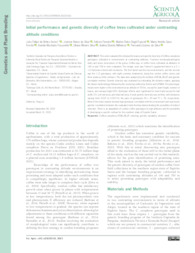Initial performance and genetic diversity of coffee trees cultivated under contrasting altitude conditions.
Initial performance and genetic diversity of coffee trees cultivated under contrasting altitude conditions.
Autoria: SENRA, J. F. de B.; SILVA, J. A. da; FERREIRA, A.; ESPOSTI, M. D. D.; FERRAO, M. A. G.; FASSARELLA, K. M.; SILVA, U. R.; MILHEIROS, I. S.; SILVA, F. G. da
Resumo: This work evaluated the initial performance and genetic diversity of Coffea canephora genotypes cultivated in environments at contrasting altitudes. Fourteen morphophysiological traits and seven descriptors of the genus Coffea spp. of coffee trees cultivated at altitudes of 140 m and 700 m were evaluated. The design used was Federer’s augmented block in a 2 × 112 factorial scheme with six blocks. The first factor was the two environments, and the second was the 112 genotypes, with eight common treatments, being five conilon coffee clones and three arabica coffee cultivars. The data were analyzed by the method of REML/BLUP and genetic correlation method. Genetic diversity was evaluated by estimating the distance matrix, applying the Gower methodology followed by the clustering method by Tocher and UPGMA. The phenotypic means were higher in the environment at an altitude of 700 m, except for plant height, number of leaves, and canopy height (CH). Genotypic effects were significant for most traits except for leaf width, CH, unit leaf area, and total leaf area. A wide genetic diversity was verified, with distances varying from 0.037 to 0.593 for the pairs of genotypes 26 × 93 and T7 × 76, respectively. Most of the traits studied showed high genotypic correlation with the environment and expressive genetic correlation between the evaluated traits thereby demonstrating the possibility of indirect selection. There is an adaptation of conilon coffee genotypes to high altitudes and the possibility of developing a specific cultivar for the southern state of Espírito Santo.
Ano de publicação: 2023
Tipo de publicação: Artigo de periódico
Unidade: Embrapa Café
Palavras-chave: Coffea Canephora, Genetic variance, Genotype, Seed trees
Observações
1 - Por padrão são exibidas publicações dos últimos 20 anos. Para encontrar publicações mais antigas, configure o filtro ano de publicação, colocando o ano a partir do qual você deseja encontrar publicações. O filtro está na coluna da esquerda na busca acima.
2 - Para ler algumas publicações da Embrapa (apenas as que estão em formato ePub), é necessário ter, no celular ou computador, um desses softwares gratuitos. Sistemas Android: Google Play Livros; IOS: iBooks; Windows e Linux: software Calibre.
Acesse outras publicações
Acesse a Base de Dados da Pesquisa Agropecuária (BDPA) para consultar o acervo completo das bibliotecas da Embrapa.

